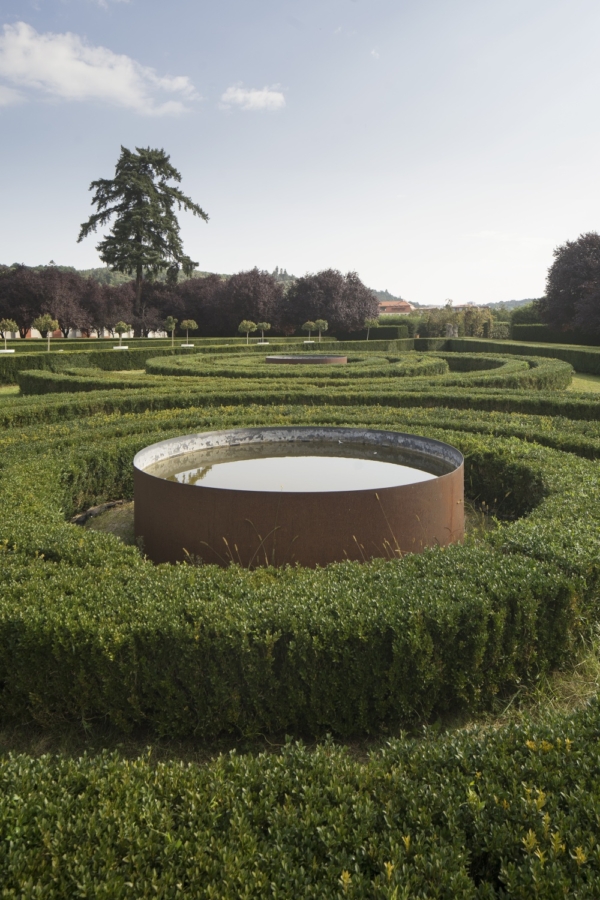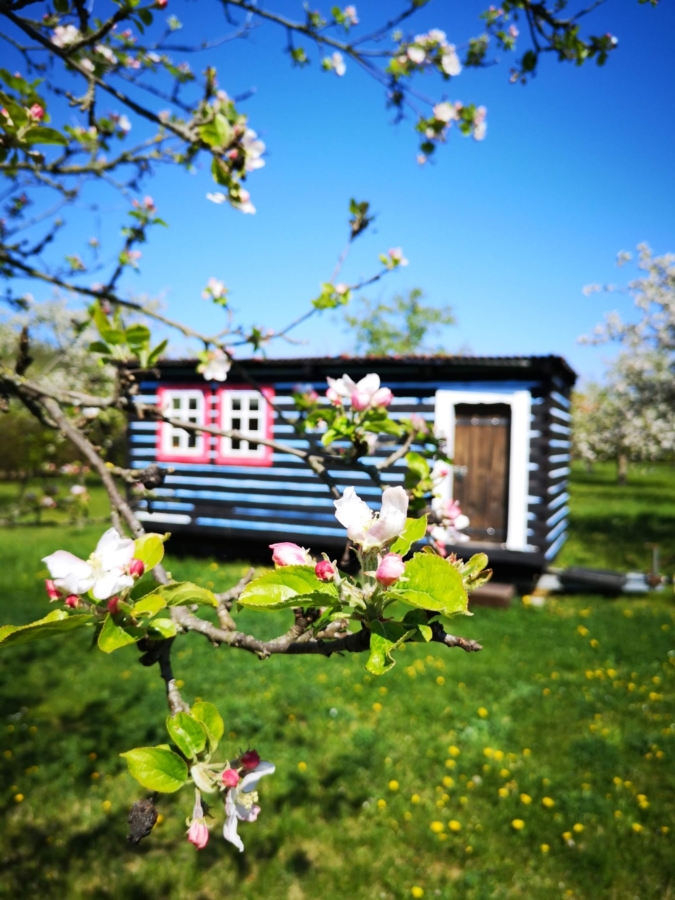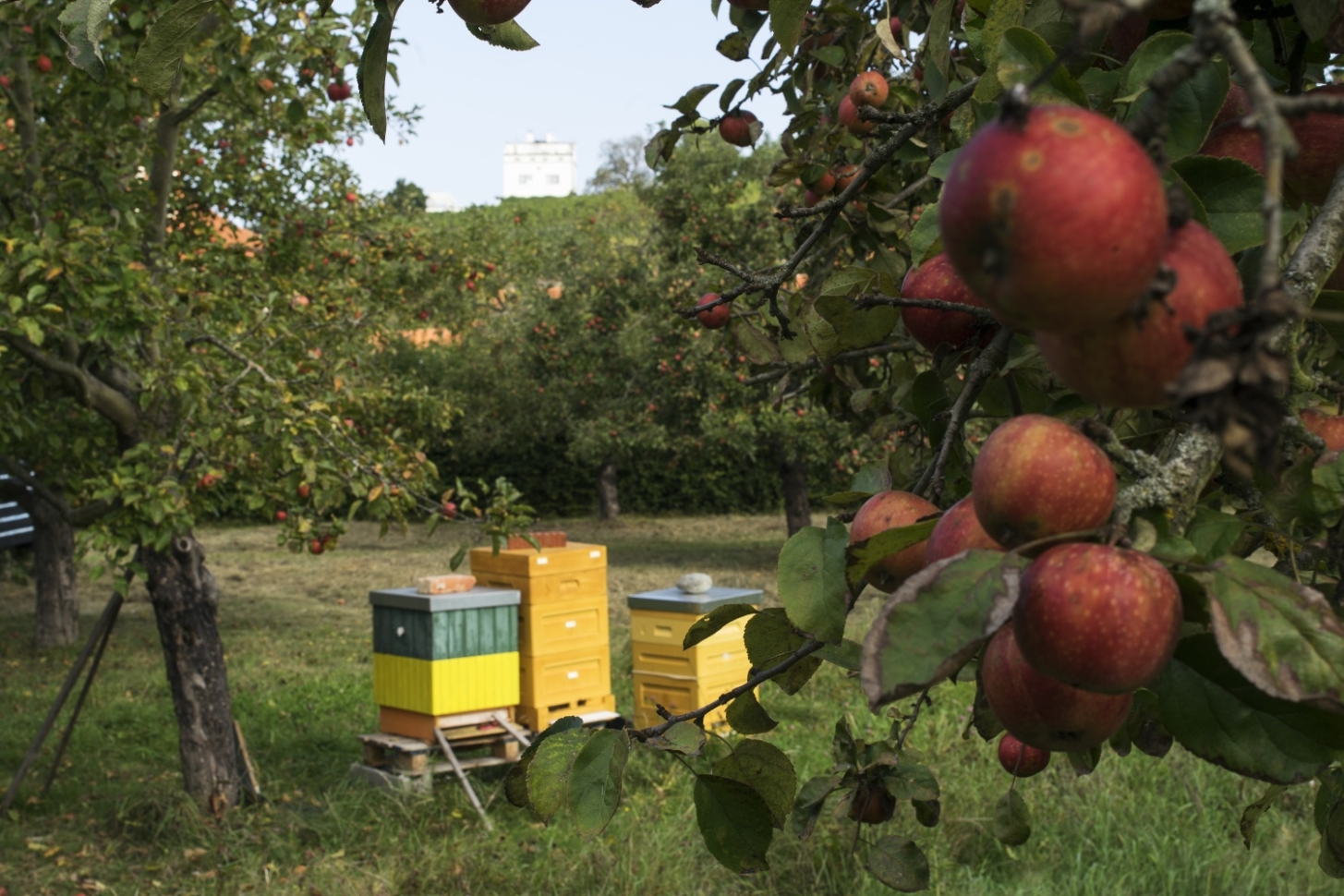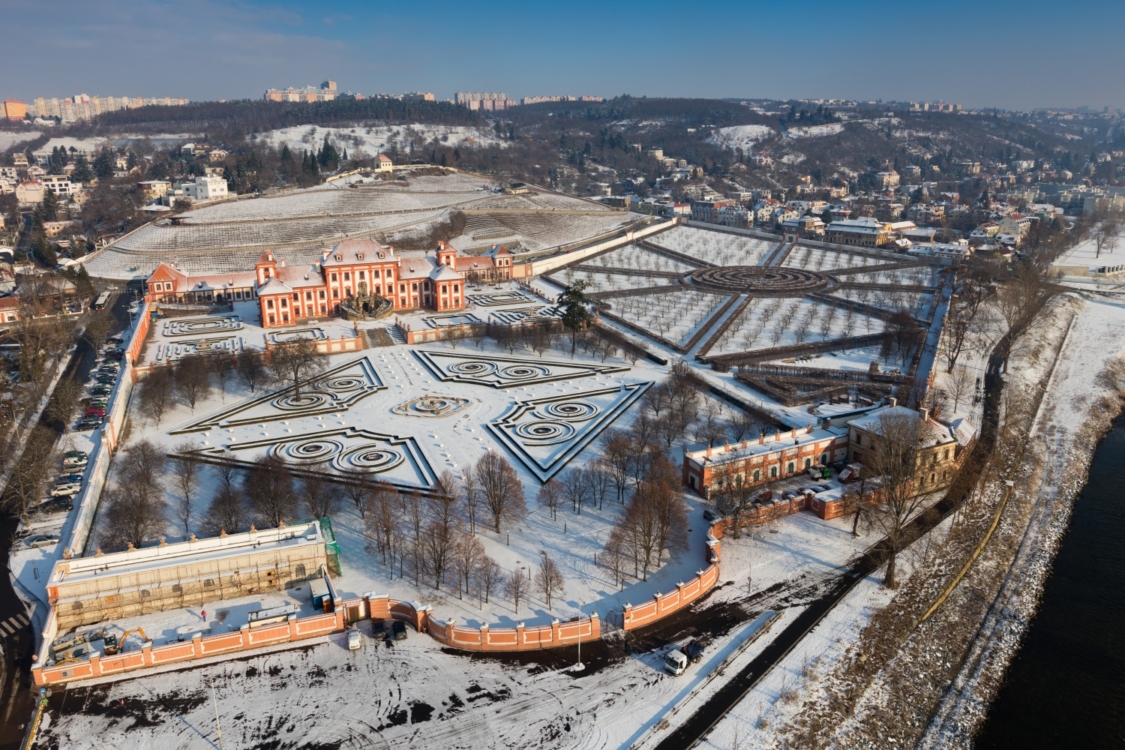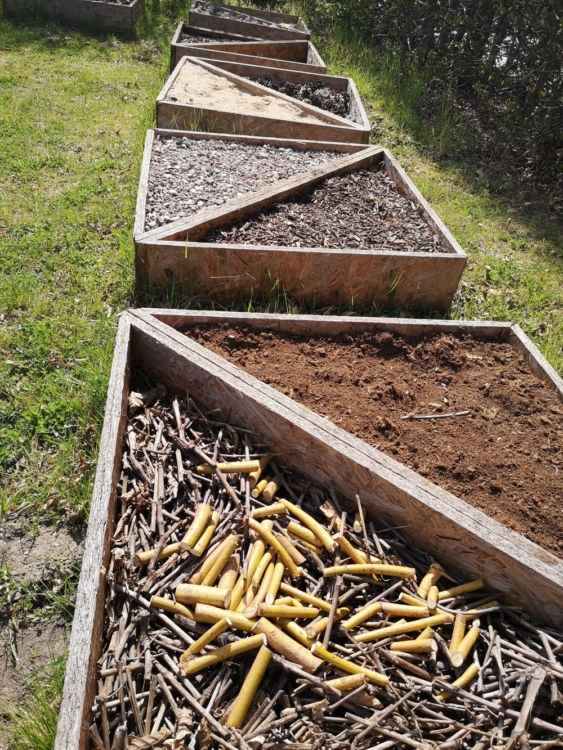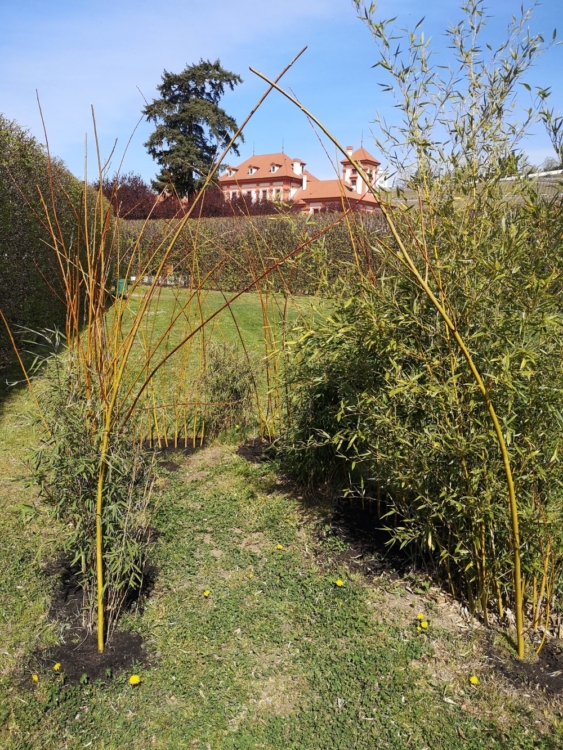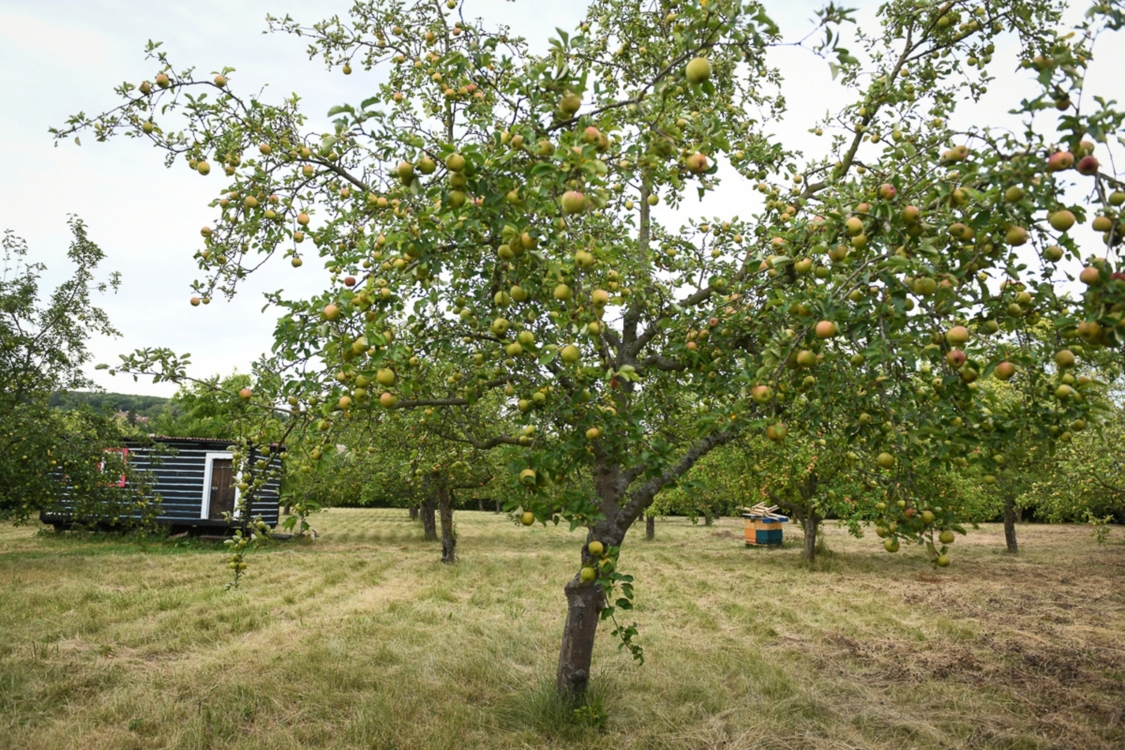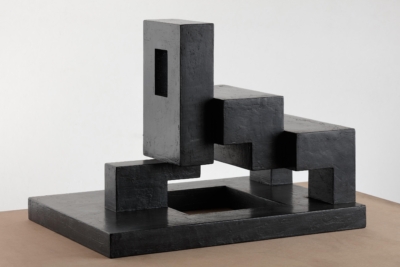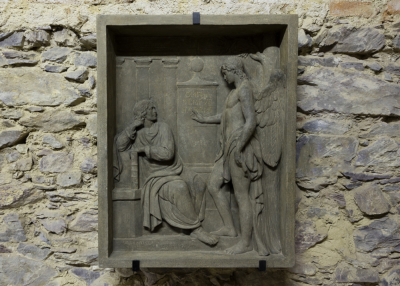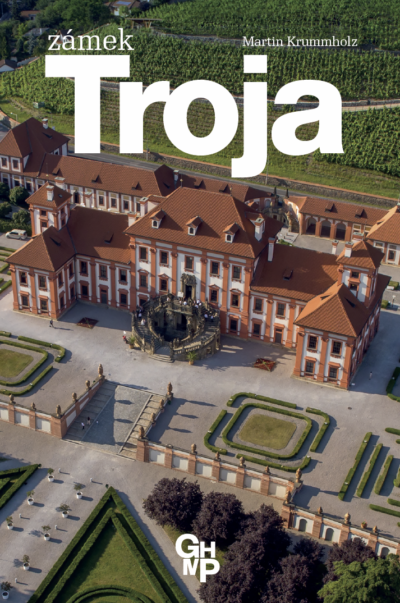The Garden of Troja Château
The garden of Troja Château was reconstructed to its current form in the 1980s according to a design by architect Otakar Kuča. Its concept is based on the original Baroque garden, which was founded here at the end of the 17th century by landscape architect Jiří Seeman; the main feature of Baroque gardens is their axial symmetry. During the following centuries, the garden of Troja Château turned into a loose park. In recent history we can mention that the garden was severely damaged by a flood in 2002.
The whole project of the garden was inspired by the heraldic symbol of the Sternberg family, an eight-pointed star. The number eight is then repeated in various schemes of the Troja Château garden. The whole compound is accessible by several entrances. The current main gate is above the ramp in the western part of the parterre near the château. The original main entrance to the garden was on the south side, from the Vltava River to the end of the ornamental garden, along that axis of the château. There is also a smaller gate at the southeastern tip of the orchard towards the river.
Description of the Garden
The ornamental garden is axially symmetrical. Situated in the immediate vicinity of the château (the upper parterre of the garden), it is planted with low-cut boxwood fences and flower beds with aestival plants. There are two original Baroque fountains in the garden, one in the west and one in the east. In the lower, southern part, the garden continues under a ramp that once allowed for the arrival of horse-drawn carriages to the château staircase. This part of the garden is square in shape and is divided into eight triangular fields. The outer fields are planted with ornamental plum trees (myrobalan plums) with purple foliage; the inner triangular fields are flanked by low-cut yew fences. Inside these triangular fields there are boxwood shrubs pruned into a spiral shape. At the intersection of the main paths in the lower part of the ornamental garden there is a Neptune fountain based on the plan of the original Baroque fountain.
In the decorative part of the garden there are two mature trees – in the east, a stout conifer, a Douglas fir, rises above the plum trees. In the western part, above the boxwood spirals, there is a massive Turkey oak.
Another part of the garden features an apple orchard, located to the east of the château. The orchard is divided into eight irregular fields resembling the shape of a star; inside the orchard there is a labyrinth. The individual fields and the labyrinth are formed by tall, trimmed hornbeam hedges. In the center of the labyrinth there is a solitary tree – a Turkish hazel.
The garden includes other, smaller buildings and works of art – the garden theater, the grand exterior staircase, the garden walls with their colored stucco trompe l’oeil decorations, the pergola with the sculptural group of The Judgment of Paris, the terracotta vases on the ramp and fence walls, the busts of emperors on the roof of the orangery and the gardener’s house, the fountains and other works of art, both contemporary and Baroque ones. In the lower part of the garden there is the orangery, today used for educational purposes, as well as the agricultural and operational buildings of the château and the garden.
Artistic Elements
Trompe l’oeil Wall Decorations
The sharply-projecting tip of the eastern garden, which forms a rhomboid, also creates the shape of one point of the eight-pointed Sternberg star. From the center of the rhomboid, eight paths radiate in a star-like way. The main paths lead to the fence wall with its trompe l’oeil images featuring reliefs of stucco decoration on themes from ancient mythology. The trompe l’oeil image on the eastern wall features The Labors of Hercules; the southern wall, known as the Theater, features an episode from an ancient drama, with the scene of Corona meeting Apollo. The northern wall has been preserved only in fragments, with the coats of arms of Wenzel Adalbert, Count of Sternberg (Václav Vojtěch of Šternberk) and his wife, Clara Bernhardine of Maltzan.
Fountains
At the very beginning of the 18th century a spectacular fountain with rich sculptural decoration was built in the middle of the château garden, directly along the axis of the main entrance with its oval staircase. It is not possible to reconstruct the fountain’s former appearance precisely from the preserved fragments, but it is certain that it was modeled after contemporary Baroque fountains in Rome. The floor plan of the original fountain was found during surveys in 1978. A strong spout sprayed from a massive rock in the middle of the fountain, complemented by springs gushing from gargoyles on the side sculptures. The central scene has not been preserved in its entirety; it is assumed that the main figure was Neptune and his wife, Amphitrite. A group of Tritons and Nereids floated around them on seashells, riding sea monsters and dolphins.
The side fountains in the upper parterre are shaped like rock formations, decorated with motifs similar to those on the grand staircase capturing the rocks of Tartarus. Lizards and frogs, aquatic plants, or even the humorous motif of the stonework repaired with a faux carpenter’s bracket appear through the gushing water. It is assumed that all the fountains were produced by the workshop of J. G. Heermann, or even directly created on site by individual sculptors.
Terracotta Vases
The fence wall around the garden is decorated to this day with a set of terracotta vases, and the both attics of the orangery and the gardener’s house are adorned with terracotta busts of ancient emperors. Four allegorical busts of the seasons were originally placed on the terrace wall above the château cellar. The vases are embellished with garlands, mascarons, attributes of the coats of arms of the château owners, and figural and zoomorphic elements. Such a large set of terracotta vases and figural busts is unique in Europe. Unfortunately, most of the fired-clay vases have been replaced with replicas and their original elements have been restored and supplemented many times.
Staircase
The double-flight exterior staircase led noble visitors coming to the château from Prague by way of the hunting grounds in what is Stromovka Park today into the château gardens, and from there directly into the main hall on the first floor, where guests had a view of the grandiose interior decoration, a monumental painting thematically celebrating the Habsburg family. The staircase was also constructed as an autonomous Baroque theater staging the scene of the Giants’ fall into Tartarus. The structure of the staircase contained an ingenious plumbing system that launched a waterfall onto the defeated Giants, dramatically highlighting the whole scene. According to a surviving description, water gushed not only from the mouths of the two Giants at the bottom of Tartarus, but also from the statues of the Olympian Gods and from other parts of the staircase. The lower part of Tartarus functioned as a fountain, where the running water was collected and subsequently drained into the fountains situated in the lower part of the terraced garden. Although the water system has not been in use since the late 18th century, the technical elements of the plumbing have been preserved.
The realization of the whole work and its rich sculptural decoration was commissioned from Johann Georg Heermann, who arrived in Prague accompanied by his nephews, Zacharias Heermann and Paul Heermann.
The Judgment of Paris
The sculptural group The Judgment of Paris was created directly on site for the garden of Troja Château by the sculptor Stanislav Hanzík in collaboration with the architect Otomar Kuča in 1989. A young man who had not yet known a woman was to decide a beauty contest between the goddesses Athena, Hera and Aphrodite. The scene captures the moment when Paris decided to hand the apple to “the most beautiful” one, Aphrodite.
Traditional Caravan – Tomáš Džadoň
The mysterious caravan in the middle of the apple orchard is a work of art by Tomáš Džadoň from 2006. During his stay in Finland the artist designed a caravan, which he entitled Traditional Caravan, that combines old ways of life with current ones. Instead of a modern design, he constructed it in the style of a traditional wooden cottage, furnished with the usual village equipment. When designing the interior, Džadoň respected the traditional layout of cottage rooms; his wooden caravan is designed as was customary in the past. The main beam, which stretches across the entire space, bears the inscription: Džadoň Štefan and his wife 1878 (the name of the artist’s parents; the date is fictitious).
Singing Fountain – Matouš Lipus
Originally, the installation Singing Fountain was created in 2019 for an outdoor gallery in the district of Prague-Vršovice. It comments on the issue of water scarcity and responds to climate change on our planet. It is currently placed in the educational garden, where it encourages gallery visitors to collaborate and care for their immediate environment.
Wells – Václav Cigler
The set of seven wells in the middle of the S-shaped ornaments made of cut boxwood was designed by the eminent Czech artist Václav Cigler in 2016 on the occasion of his retrospective at Troja Château. Circular objects made of corten steel and filled with water act as mirrors, reflecting the sky with its passing clouds.
Forged Gates, one by Hugo Demartini and one by Jaromír Bruthans
The author of the main forged gate dating from 1987–1988 at the entrance to the Zoo is Jaromír Bruthans. The south side steel gate in the lower gardens was designed by the prominent sculptor Hugo Demartini in 1989.
Trees in the Garden
Small-leaved linden Tilia cordata
It is a deciduous tree with a smooth bark, growing up to 30 m. Its shoots are mostly glabrous. The leaves are roundly heart-shaped with a short point, 4–7 cm long, deep green on the right side, dark green with reddish-brown hairs on the underside; they have small tufts of brown hair in the leaf vein axils. The tree has strongly fragrant yellow-white flowers. It is a woody plant widely spread from Eastern Europe to southern Scandinavia.
Common linden Tilia europaea
This deciduous tree reaches the height of up to 25 m. The lower branches are overhanging and the trunk typically features burrs. The shoots are glabrous. The leaves are obliquely heart-shaped, dark green on the right side and lighter on the underside, and also glabrous; there are tufts of white hair in the leaf vein axils. The flowers are yellowish white and about 8 mm long. The fruit is a dry nut-like downy drupe with a hard shell. The common linden is a cross between small-leaved linden and large-leaved linden. It is widely planted in parks.
Weeping silver linden Tilia petiolaris
A deciduous tree growing up to 25 m. It has pendulous branches; its twigs are whitish and tomentose beneath. The leaves are 7–11 cm long, pointed, sharply serrated, broadly ovate or heart-shaped, dark green above and whitish and fuzzy beneath; the petiole is 5–6 cm long. The tree has pendulous clusters of fragrant pale yellow flowers. Its conspicuous fruits are five-ridged and spherical. Distribution: southeastern Europe to Asia Minor. A well-known park tree in Europe.
pendulous branches bearing heart-shaped dark green leaves whitish beneath.
Large-leaved linden Tilia platyphylla
A deciduous tree which can attain the height of 40 m. Its trunk is very thick, with fine fissures and furrows. The twigs are reddish-brown and hairy. The leaves are roundly cordate, tapering into a mucronate tip and up to 12 cm long, vividly green on the right side, lighter on the underside and with soft, short downy white hairs. The flowers are yellowish-white and arranged in clusters in groups of three. The fruit is tomentose, its shell has 5 ridges. Distribution: Central and southern Europe, Caucasus. Old lindens are often of this type.
Silver linden Tilia tomentosa
It is a deciduous tree growing to 30 m. The branches spread upwards at wide angles; the twigs are grayish and tomentose. The leaves are roundly cordate, up to 10 cm long, finely serrated, dark green on the right side, hairy and petiolate underneath. The petiole is 2.5–3 cm long. Its fruits are pointed, up to 1 cm long. Distribution: southeastern Europe, Hungary and Serbia. This tree species is often planted in parkland.
Douglas fir Pseudotsuga menziesii
An evergreen conifer growing to 50 m in height. The bark on old trees is dark brown and deeply furrowed, while it is smooth on young trees. Its branches are arranged in irregular whorls. The fir-like leaves are linear, 2–3 cm long. When rubbed between fingers, they smell pleasantly. The cones are egg-shaped, 5–10 cm long. They have a bract that protrudes above each scale. Douglas fir is native to western North America; in Europe it is grown in forests, as well as in parks and gardens.
Turkey oak Quercus cerris L.
A deciduous tree with a broadly conical crown, growing up to 35 m. The bark is black and deeply furrowed with bark fissures. The twigs are grey-felted, the leaves lobed, 6–12 cm long, very variable. The buds are a bit hairy, and they are surrounded by long twisted whiskers. The fruits are acorns in a cup densely covered with bristles. Turkey oak is widespread in southern Europe and Asia Minor; in our part of Europe, it is planted only in parks.
Field maple Acer campestre L.
A deciduous tree or shrub reaching up to 15 m. The young shoots are hairy, the leaves are small. The bark is somewhat corky on young shoots. The leaves are alternate with a jagged edge, broad ovate to obovate, 3–5 cm long, have hair on the veins beneath; the petioles are milky. It is in flower in May, shortly after the leaves open. The fruit is a samara with two winged achenes aligned at 180 degrees. It is also used as a hedging plant. It is widespread in Europe and Asia Minor, mainly in the plains and valleys. It is widely grown in parks and large gardens.
Turkish hazel Corylus colurna L.
A deciduous tree growing up to 20 m. The bark is pale grey, with a corky texture. The crown is conical with branches arising at almost a 90-degree angle; the twigs are covered with gland-tip whiskers and hairs. The leaves are broadly ovate, and broadly cordate at the base; dark green above, and light green and hairy below. The flowers bloom from February to March. The fruit is a nut with a hard shell, up to 2 cm in size. It is widespread in southeastern Europe and Asia Minor. It is our park tree.
Boxwood Buxus sempervirens L.
It is an evergreen slow-growing shrub or small tree. The twigs are square, light green, densely covered with leaves. Arranged in opposite pairs, the leaves are in a round to oval egg shape, 3–5 cm long. The flowers are inconspicuous, yellow-green. It is a southern shrub which is planted throughout Europe. It tolerates cut well.
Common hornbeam Carpinus betulus
A deciduous tree reaching heights up to 20 m with an irregular crown. It has a smooth, twisted trunk. The twigs are slightly hairy. The leaves are broadly oval with pointed tips, broadly cordate at the base, 8–12 cm long, doubly serrated at the edge. The flowers are arranged in green and inconspicuous catkins which are monoecious. The fruit is a small nut surrounded by a three-pointed leafy involucre which matures late, holding on the tree long into the winter. It is widespread throughout Europe as far as Persia. It tolerates cut well.
Common yew Taxus baccata
An evergreen coniferous tree and shrub. The bark is reddish and scaly, coming off in small flakes. The branches are widely projecting. The needle-like leaves grow in two rows on either side of each twig, they are 1–3 cm long, glossy dark green, light green beneath. The seeds are black, 6-7 mm long, hard, enclosed in a red, fleshy, berry-like structure (aril). The whole tree is poisonous. It is commonly found growing throughout Europe in parks, orchards and cemeteries.
Black cherry plum Prunus cerasifera nigra
A deciduous tree or shrub growing 3–10 m in height. The trunk is dark. The leaves are purple, ovate, finely serrated. The flowers are pale pink. It is in bloom from late March to early April. It produces small juicy dark red plums. It is widespread throughout Europe. It has come from the Middle East and Central Asia.
Common apple Malus pumila Mill
The apple is a deciduous tree, 5–10 m tall. The young branches are felted. The leaves are elliptical to ovate, 4–10 cm long, slightly serrated. The flowers are white, pinkish on the edge. It blooms in April. The fruit is a spherical pome. The tree originated in Asia Minor and Caucasus.

